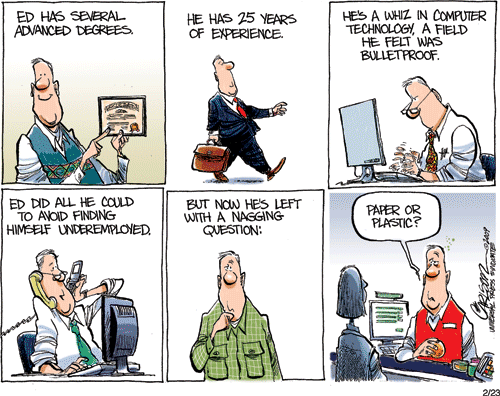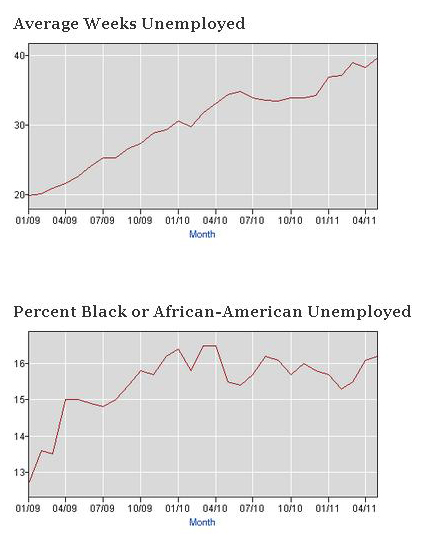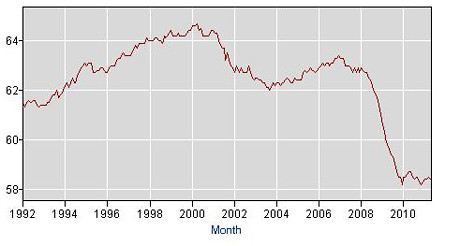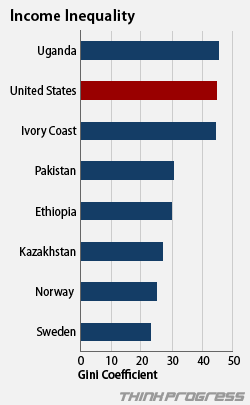 No doubt the Obama administration will tout today’s news that unemployment has fallen .4% to 9.0% as an indication the US economy is improving. It will be quite a back aching twist of logic in the face of poor job growth of only 36,000 jobs in January far below expectations. So what’s really happening? David Dayen at FDL explains the drop in the face of such dismal job growth:
No doubt the Obama administration will tout today’s news that unemployment has fallen .4% to 9.0% as an indication the US economy is improving. It will be quite a back aching twist of logic in the face of poor job growth of only 36,000 jobs in January far below expectations. So what’s really happening? David Dayen at FDL explains the drop in the face of such dismal job growth:
How does this happen? Well, January is always a month when the establishment survey gets revised. New population estimates get incorporated into the survey, and the seasonal adjustment factors get updated. So there is a difference in the January survey of 600,000 less unemployed people; that number is down to 13.9 million according to the BLS (Bureau of Labor Statistics).
Does this mean that those people got a job in this month? Not really. The employment/ population ratio rose slightly to 58.4%, and the labor force participation rate declined to 64.2%, the lowest rate since the early 1980s. Basically, the drop in the top line unemployment rate is entirely due to changes in the total population estimates and other adjustments.
The U-6, which counts not only people without work seeking full-time employment (the more familiar U-3 rate), but also counts “marginally attached workers and those working part-time for economic reasons.” Note that some of these part-time workers counted as employed by U-3 could be working as little as an hour a week. And the “marginally attached workers” include those who have gotten discouraged and stopped looking, but still want to work, is currently 16.1%.
Another explanation of the job growth numbers is the horrendous weather across the country since late December:
January’s snowstorms probably had some effect on the anemic numbers, given that sectors like construction and transportation and warehousing shed jobs. The private sector added 50,000 jobs, so government layoffs, particularly at the state and local level, also restrained growth. Analysts had forecast an increase of about 145,000.
However, the real problem is what kind of jobs are being created, the number of people who have had to settle for part time employment as their job benefits run out and the number of jobless who are no longer counted in the numbers that are reported.
The other bad news is, this rate may not hold since austerity measures by the states and localities, facing huge budget deficits and no hope of relief from Congress, will most likely be laying off huge numbers of workers in attempts to salvage education and other vital programs.
President Barack Obama’s goal of driving the unemployment rate below 9 percent this year is threatened by state and local budget cuts that are likely to intensify as Federal stimulus money runs out.
Austerity measures may add as much as 0.25 percentage point to the unemployment rate this year, according to Mark Zandi, chief economist of Moody’s Analytics Inc.
“This could make the difference between ending 2011 with unemployment above or below 9 percent,” he said. “There’s no more serious drag on economic growth than the severe budget cutbacks at the state and local level.”
Cross Posted from The Stars Hollow Gazette





 No doubt the Obama administration will tout today’s news that unemployment has fallen .4% to 9.0% as an indication the US economy is improving. It will be quite a back aching twist of logic in the face of poor job growth of only 36,000 jobs in January far below expectations. So what’s really happening?
No doubt the Obama administration will tout today’s news that unemployment has fallen .4% to 9.0% as an indication the US economy is improving. It will be quite a back aching twist of logic in the face of poor job growth of only 36,000 jobs in January far below expectations. So what’s really happening?